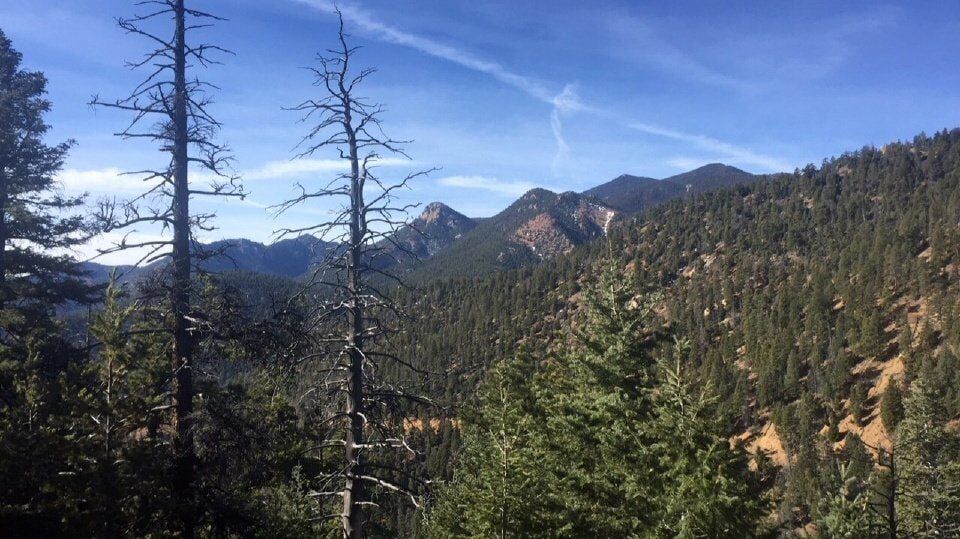Popular trails closing in Colorado Springs, sparking latest controversy in Bear Creek watershed
Starting this month, the U.S. Forest Service aims to permanently close an area that has long been popular for hikers and mountain bikers in the hills of Colorado Springs.
The trails around Mays Peak — accessed along High Drive from the top of North Cheyenne Cañon Park — were formally closed as part of a sweeping order in 2017, the Forest Service reminded in a notice to stakeholders involved in years of action around the Bear Creek watershed. The action has been in a stated effort to protect greenback cutthroat trout, federally listed as threatened and thought to be extinct before the Bear Creek discovery in 2012.
Since then, land managers have made various attempts to block or “decommission” trails deemed a risk to the habitat. In the case of trails around Mays Peak, the attempt this summer came with felling trees — “an environmentally sound practice in an area that is overstocked,” according to the Forest Service’s recent notice, which indicated previously determined fire danger in the area.
Happy Trails: Finding Colorado’s new troll atop a historic, scenic mountain
“This approach serves a dual purpose,” the notice continued. “It blocks human travel while providing sheltered micro-habitat for plants to take root and revegetate the bare ground.”
The resulting closure at Mays Peak will start this month, read the notice sent by Janelle Valladares, the Forest Service’s fisheries biologist leading the Bear Creek watershed project. (Attempts to reach her for this article were unsuccessful.)
The job this summer sparked online outrage toward Rocky Mountain Field Institute (RMFI), the Colorado Springs-based nonprofit contracted by the Forest Service. An online petition criticized the work as “destroying the habitat.” The petition came with a small photo appearing to show a middle finger raised at a service vehicle.
In a local mountain biking group on Facebook, RMFI’s executive director, Jolie NeSmith, addressed the animosity in a pointed post calling out harassment and threats to staff and vehicles.
“(B)y removing the smaller trees we are minimizing the risk of canopy fires while also closing trails,” NeSmith wrote. “This is not a perfect remedy, but considering some trail users cannot respect (Forest Service) regulations, this is what is left.”
Beyond Barr: Hidden trails and destinations away from Pikes Peak’s main route
She added: “I say this because the power is truly in your hands. If you really care about our public lands, then you would stop creating illegal trails in a protected watershed and support the work being done to remove them.”
The region’s long-standing mountain biking advocacy group, Medicine Wheel, has continued to call for mutual understanding. The group’s leader, Cory Sutela, posted a lengthy statement saying it was “extremely improbable” Forest Service leadership “will respond positively to threatening or emotional appeals to approve illegal trail construction in the Bear Creek watershed.”
On the Forest Service’s part, Sutela called for better communication and information. He noted “insufficient data to connect the impact of trails, trail users and sedimentation on fish habitat.”
Land managers have seen a habitat threat from rock and soil kicked down to the creek by feet and wheels above, explaining several trail reroutes and closures in 2017. Three years later, Colorado Parks and Wildlife reported an 80% decline in adult fish — leading some to wonder if the now-decommissioned trails had any impact in the first place.
The population has since stabilized, CPW told The Gazette earlier this year. In 2022, the agency announced a second population of greenback cutthroat trout naturally reproducing at Herman Gulch, one of several sites along the South Platte River where the fish have been stocked from hatcheries.
That was “reassuring,” CPW biologist Cory Noble previously told The Gazette, “but it doesn’t diminish the Bear Creek population by any means.”
Plan calls for more protection of scenic, recreation areas in large swath of Colorado
Get OutThere
Signup today for free and be the first to get notified on new updates.




